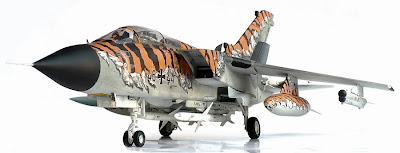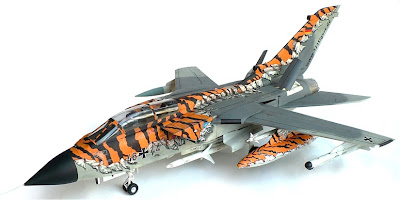From Wikipedia"
The Panavia Tornado is a family of twin-engine, variable-sweep wing combat aircraft, which was jointly developed and manufactured by the United Kingdom, West Germany and Italy. There are three primary variants of the Tornado; the Tornado IDS (interdictor/strike) fighter-bomber, the suppression of enemy air defences Tornado ECR (electronic combat/reconnaissance) and the Tornado ADV (air defence variant) interceptor.
The Tornado was developed and built by Panavia Aircraft GmbH, a tri-national consortium consisting of British Aerospace (previously British Aircraft Corporation), MBB of West Germany, and Aeritalia of Italy. It first flew on 14 August 1974 and was introduced into service in 1979–1980. Due to its multirole nature, it was able to replace several different fleets of aircraft in the adopting air forces. The Royal Saudi Air Force
(RSAF) become an export operator of the Tornado in addition to the
three original partner nations. A tri-nation training and evaluation
unit operating from RAF Cottesmore, the Tri-National Tornado Training Establishment, maintained a level of international cooperation beyond the production stage.
The Tornado was used by the Royal Air Force (RAF), Italian Air Force and Royal Saudi Air Force during the 1991 Gulf War,
in which the Tornado conducted many low-altitude penetrating strike
missions. The Tornados of various operators were used in conflicts in
the former Yugoslavia during the Bosnian War and Kosovo War, Iraq during the Gulf War and the Iraq War, Libya during the Libyan civil war, as well as smaller roles in Afghanistan and Yemen. Including all variants, a total of 992 aircraft were built.
On
26 March 1969, four partner nations – United Kingdom, Germany, Italy
and the Netherlands, agreed to form a multinational company, Panavia
Aircraft GmbH, to develop and manufacture the MRCA.
The project's aim was to produce an aircraft capable of undertaking
missions in the tactical strike, reconnaissance, air defence, and
maritime roles; thus allowing the MRCA to replace several different
aircraft then in use by the partner nations.Various concepts, including alternative fixed-wing and single-engine designs, were studied while defining the aircraft. The Netherlands pulled out of the project in 1970, citing that the aircraft was too complicated and technical for the RNLAF's preferences, which had sought a simpler aircraft with outstanding manoeuvrability.[12] An additional blow was struck by the German requirement reduced from an initial 600 aircraft to 324 in 1972.
When
the agreement was finalised, the United Kingdom and West Germany each
had a 42.5% stake of the workload, with the remaining 15% going to
Italy; this division of the production work was heavily influenced by
international political bargaining. The front fuselage and tail assembly was assigned to BAC (now BAE Systems) in the United Kingdom; the centre fuselage to MBB (now EADS) in West Germany; and the wings to Aeritalia (now Alenia Aeronautica) in Italy. Similarly, tri-national worksharing was used for engines, general and avionic equipment. A separate multinational company, Turbo-Union, was formed in June 1970 to develop and build the RB199 engines for the aircraft, with ownership similarly split 40% Rolls-Royce, 40% MTU, and 20% FIAT.
At
the conclusion of the project definition phase in May 1970, the
concepts were reduced to two designs; a single seat Panavia 100 which
West Germany initially preferred, and the twin-seat Panavia 200 which
the RAF preferred and which would become the Tornado. The aircraft was briefly called the Panavia Panther, the project soon coalesced towards the two-seat option.In
September 1971, the three governments signed an Intention to Proceed
(ITP) document, at which point the aircraft was intended solely for the
low-level strike mission, where it was viewed as a viable threat to
Soviet defences in that role. It was at this point that Britain's Chief of the Defence Staff announced "two thirds of the fighting front line will be composed of this single, basic aircraft type".
Tornado ECR
Operated by Germany and Italy, the ECR is a Tornado variant devoted to Suppression of Enemy Air Defences
(SEAD) missions. It was first delivered on 21 May 1990. The ECR has
sensors to detect radar usage and is equipped with anti-radiation AGM-88 HARM missiles.
The Luftwaffe's 35 ECRs were delivered new, while Italy received 16
converted IDSs. Italian Tornado ECRs differ from the Luftwaffe aircraft
as they lack of build-in reconnaissance capability and use RecceLite
reconnaissance pods, also only Luftwaffe ECRs are equipped with RB199
Mk.105 engine which has a slightly higher thrust rating. The German ECRs do not carry a cannon.







No comments:
Post a Comment